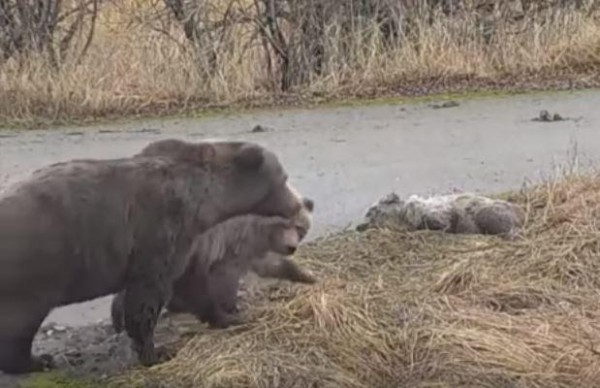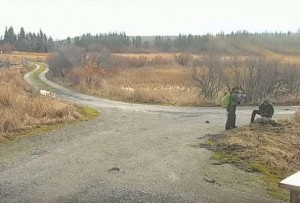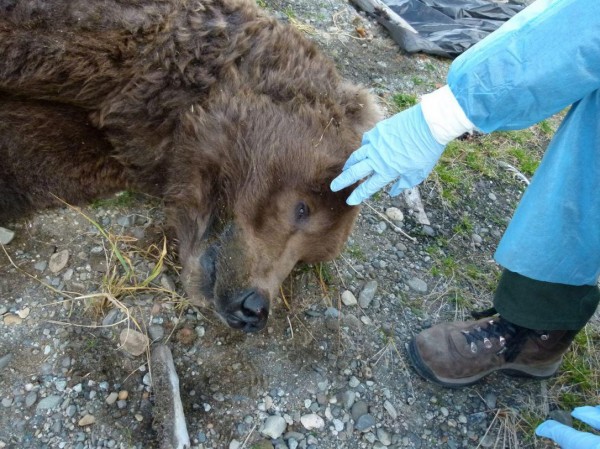A lab has identified a possible cause of death for one of the two brown bears that died in front of the high-traffic bear cams in Katmai National Park last month.

After thousands of viewers watched a spring cub die in late October, the animal’s remains were sent to a lab in Madison, Wisconsin for a necropsy.
Roy Wood, the Chief of Interpretation at Katmai, says the cub tested positive for canine adenovirus, an infection that is also found in cats, dogs, and wolves.
“It’s called canine infectious hepatitis, and it causes liver damage, lesions in esophagus and nose,” said Wood. “And when the symptoms present themselves, they do present similar to what we saw with the cub – loss of motor skills, lethargy, ultimately convulsions, seizures leading to death.”

CREDIT EXPLORE.ORG
This is not the first time this disease has been found in bears in Southwest Alaska. A 1998 study showed 14 percent of brown bears on Kodiak Island and the Alaska Peninsula had been exposed to infectious hepatitis.
In the recent Katmai case, Wood says they can’t be certain that the hepatitis is what actually killed the cub, but tests show the virus was present. And that means it could spread to other animals.
“When you spend time around bears, one thing you notice is they go up and smell and lick anything unusual. They will go sniff a pile of feces or sniff where another bear has urinated,” says Wood. “So even without consuming the flesh, it’s possible that a number of other bears may have come into contact with the pathogen.”
Within days of the cub’s death, a large male bear also lay down and died within view of the cameras. Wildlife technicians went out and dissected the body in the field to collect samples. And Wood invited the army of viewers along to help investigate.
“I posted the photos with disclaimers,” says Wood. “you know, ‘it’ graphic, so don’t go there if you’re likely to be upset, but for those of who are who are interested in viewing the science, here’s the link. I said, now, nobody talk about it for 30 minutes. Then we’ll come back and see if – examining photos and looking at your notes – we all come back with the same identification for the bear.”

Wood figured no more than a handful of people would be interested in studying gory photos in the name of science. But as it turned out, the photos got a huge amount of web views within the 30-minute window Wood had allotted.
I think there were close to 2,000 views, and those were not the 100-or-so people that were on the cams chatting with us and were very very upset… These were a whole additional group of people that we hardly ever interact with.
Together, viewers and rangers identified the deceased as bear 868, an adult male known to the bear cam community as one of the ‘Wayne Brothers.’
The tissue samples from 868 came back negative for infectious hepatitis as well as rabies. But Wood says that’s about all they were able to test for, because the samples were too decayed by the time they reached the state veterinarian in Fairbanks.
“We suffered some of the same sorts of delays that we’re used to when we ship stuff from Anchorage out to our homes in the Bush,” explained Wood. “You just miss a flight, and it doesn’t make it on the next one, and now you’ve got a box of mold instead of the lettuce you thought you were getting. And we had that happen; there were some delays getting it all the way to Fairbanks. So we missed out on some test opportunities.”
Wood says biologists aren’t overly concerned at the moment, but they do plan to test for hepatitis among other things in a study next summer.
For now, the cameras at Brooks Camp are down due to ice and snow that covered the solar panels and caused an outage. Wood isn’t sure whether Explore.org will get them turned back on this winter or just wait until spring.
Hannah Colton is a reporter at a in Dillingham.




